
Date: 2024-10-19 Page is: DBtxt003.php txt00022818
THE UKRAINE WAR
TURNING THE TIDE
War in Ukraine ... Ukraine could be turning the tide of war again as Russian advances stall
TURNING THE TIDE
War in Ukraine ... Ukraine could be turning the tide of war again as Russian advances stall
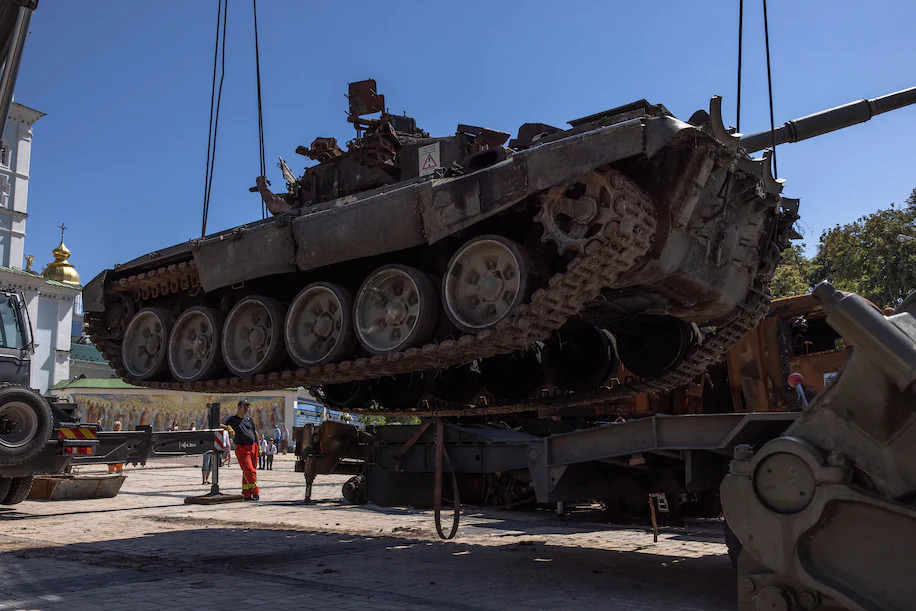
A worker watches as a Russian tank destroyed in fighting with the Ukrainian army is lifted in Mykhailivska Square in Kyiv on the Day of Ukrainian Statehood on July 28. (Roman Pilipey/EPA-EFE/Shutterstock)
Original article: https://www.washingtonpost.com/world/2022/07/28/ukraine-russia-war-himars-missiles/
Peter Burgess COMMENTARY
In the ongoing war in Ukraine I don't know what is real and what is propaganda. The 'fog of war' is very real, and in some ways made worse by modern technology, but also perhaps made a little better. One has to be careful.
From the Ukrainian ... or Western ... perspective this article is 'up-beat' and I am glad to read it. At the same time, I am more aware now about the human cost of the war in Ukraine than I have been in the past. On balance, it is encouraging how much support Ukraine has been gifted by NATO and the West. I worry that the (voting) people in most Western countries will not have the stayong power to continue support for Ukraine against the Russian aggression for 'as long as it takes' to get Russia out of Ukraine. For me that includes out of all of the Donbas and out of Crimea that were occupied by Russia in 2014.
I think it is time to think about Russia in a more complete way. Obviously there is the Kremlin and Putin and the circle around Putin who are in control of the main Russian levers of power. Under Putin, this group has become very rich, but the power still rests with Putin who is the ultimate boss. There are two important economic sectors for Russia (1) fossil fuel energy; and (2) agriculture, which must be better understood in order to avoid excessive reliance within key Western countries as well as in other sensitive areas of the world. Up to now, the Ukraine War has not been the subject of much discussion in Russia within the cultured intelligentsia which mormally stays very quietbecause that is the smart thing to do and the only way to survive. Russia also has a large 'underclass' of workers in industry and agriculture who are quiet ... indeed servile ... and quite seriously exploited and underinformed about everything.
A CNN report from Sudan (July 29th, 2022) documents the role that Russia's Wagner Group is having in the illicit processing of gold in Sudan and its export to the Soviet Union. While Africa is rich in raw materials, its 'development' seems to have stalled in recent decades. I was engaged in this field during the '70s, '80s and '90s during a period whan the old colonial nations were withdrawing from their development engagements. In many countries this was very popular ... but the results were more than a little disappointing ... and it gets worse. In my view we can and should do better.
Peter Burgess
Written by Liz Sly
Published July 28, 2022 at 11:37 a.m. EDT ... Updated July 28, 2022 at 12:08 p.m. EDT
KYIV, Ukraine — Russian advances in Ukraine have slowed almost to a standstill as newly delivered Western weapons help Ukrainian forces reclaim much of the advantage they had lost in recent months, opening a window of opportunity to turn the tide of the war in their favor again.
Russian troops have made no significant territorial gains since the Ukrainian retreat on July 2 from the eastern city of Lysychansk under withering artillery fire. The retreat gave Russia full control over Luhansk, one of the two oblasts, or regions, that make up the broader eastern Donbas area, and it marked Russia’s only meaningful strategic success since its retreat from territory around Kyiv in April.
The lack of progress may be explained at least in part by the “operational pause” declared by Russia’s Defense Ministry after the seizure of Lysychansk — to allow Russian troops a chance to “rest and develop their combat capabilities,” in the words of President Vladimir Putin.
But the so-called pause did not halt Russian attempts to probe and penetrate Ukrainian lines — and the official end of the pause, announced by Defense Minister Sergei Shoigu on July 16, has brought no noticeable increase in the intensity of Russia’s assaults, said George Barros, a geospatial and Russia analyst with the Institute for the Study of War.
Rather, Barros and many Western officials and analysts suspect that the Russians are close to exhausting their capacity to make further territorial gains as their depleted army confronts Ukrainian forces with newly acquired capabilities. Already forced to abandon their hopes of capturing the capital, Russian forces may soon have to reckon with their inability to conquer the entirety of the Donbas region — the only publicly declared goal of the initial invasion and the focus of current offensive ambitions.
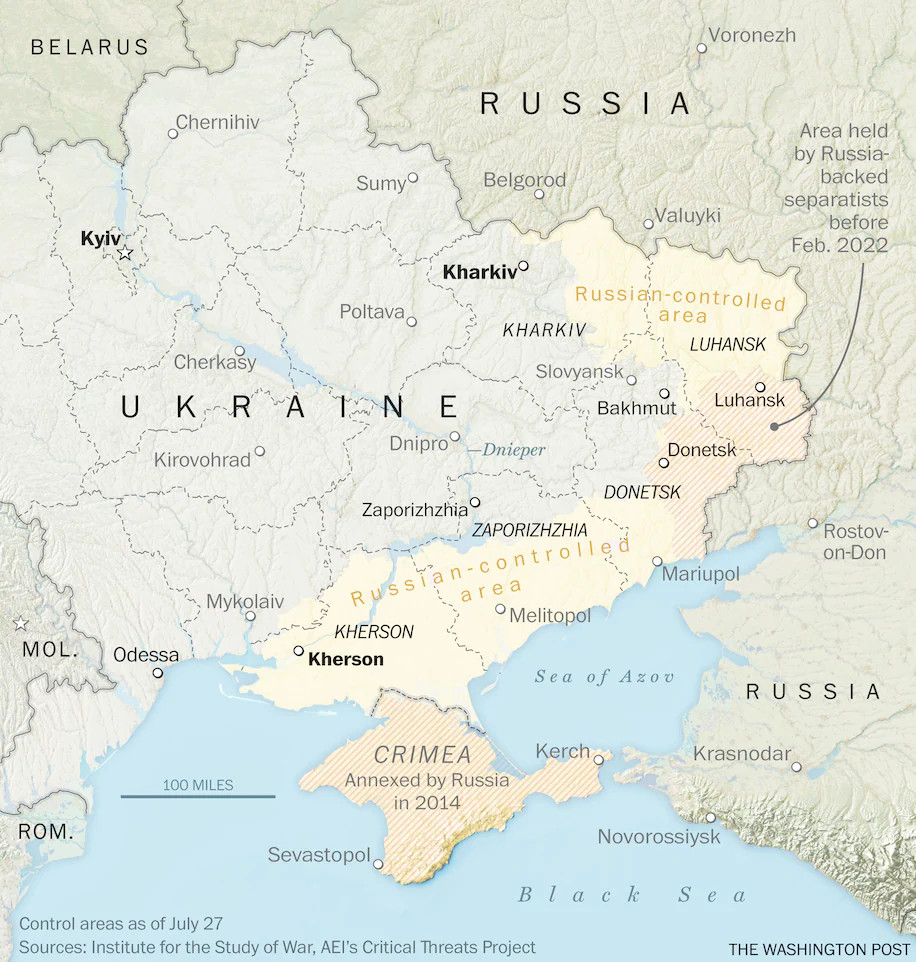
Russia may succeed in capturing one or two more of the Donbas towns in its immediate line of fire, such as Siversk and nearby Bakhmut, Barros said, but it is hard to see its existing army pressing much farther than that.
“It does seem the Russians’ ability for forward movement is petering out,” said Phillips O’Brien, a professor of strategic studies at the University of St. Andrews in Scotland. “I don’t see them being able to advance much more in the Donbas.”
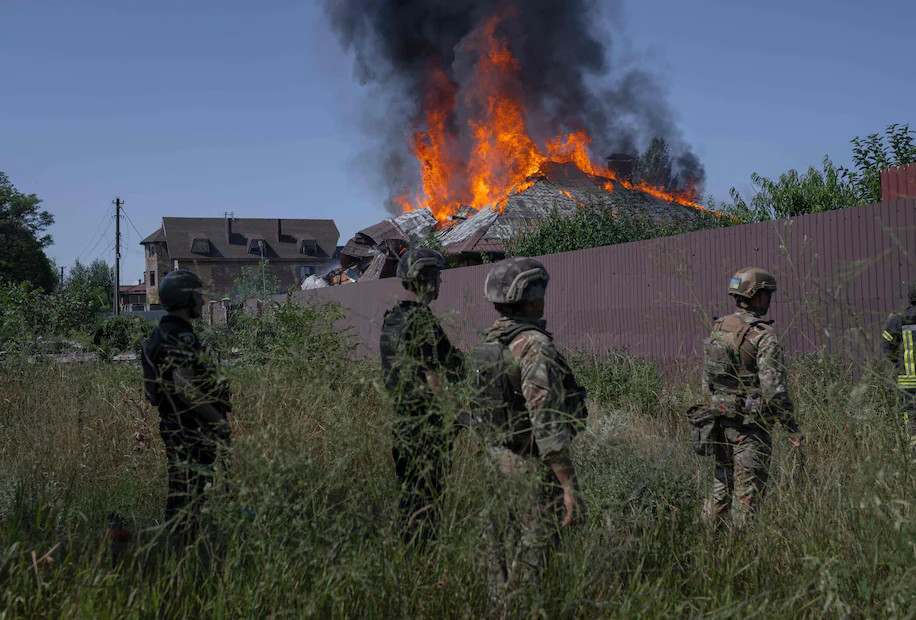
Ukrainian soldiers stand in front of a burning house that was hit by a shell, on the outskirts of Bakhmut, Ukraine, on July 27. (Bulent Kilic/AFP/Getty Images)
It is still too early to dismiss the Russian force, analysts say. A massive recruitment campaign is underway across Russia that may yet generate the manpower it desperately needs to compensate for its enormous losses. Russia adapted its goals and tactics after stumbling around Kyiv and may adapt them again, said a Western official who spoke on the condition of anonymity because he was not authorized to speak on the record. He noted that Russia also has capabilities it has not yet utilized that could take the war in a different and alarming direction, an ominous reference to Russia’s chemical and nuclear stockpiles.
In the meantime, the Ukrainian army has the chance to seize back the initiative, taking advantage of the extra range and precision offered by the more-advanced artillery provided by Western allies in recent weeks, notably the U.S. High Mobility Artillery Rocket Systems (HIMARS) that Ukraine had long sought.
“Right now, the Russians are losing the initiative, and the Ukrainians either have it or are about to have it,” Barros said. “The HIMARS are key to that.”
The HIMARS give the Ukrainians the ability to strike almost 50 miles behind Russian lines with a high degree of accuracy, and Ukrainians have used them to destroy more than 100 high-value Russian targets, including command and control centers, ammunition storage sites, and logistics and support facilities, according to a senior U.S. defense official who spoke on the condition of anonymity because he was not authorized to divulge the information.
Most recently, Ukrainian forces have been utilizing the HIMARS to press a fledgling counteroffensive toward the strategically vital southern city of Kherson, which was occupied by Russia in the first days of the war.
The Ukrainian counteroffensive is “gathering momentum,” Britain’s Ministry of Defense said in a tweet on Thursday, after a third HIMARS attack Tuesday against the Antonovsky Bridge over the Dnieper River severely damaged a vital road link.
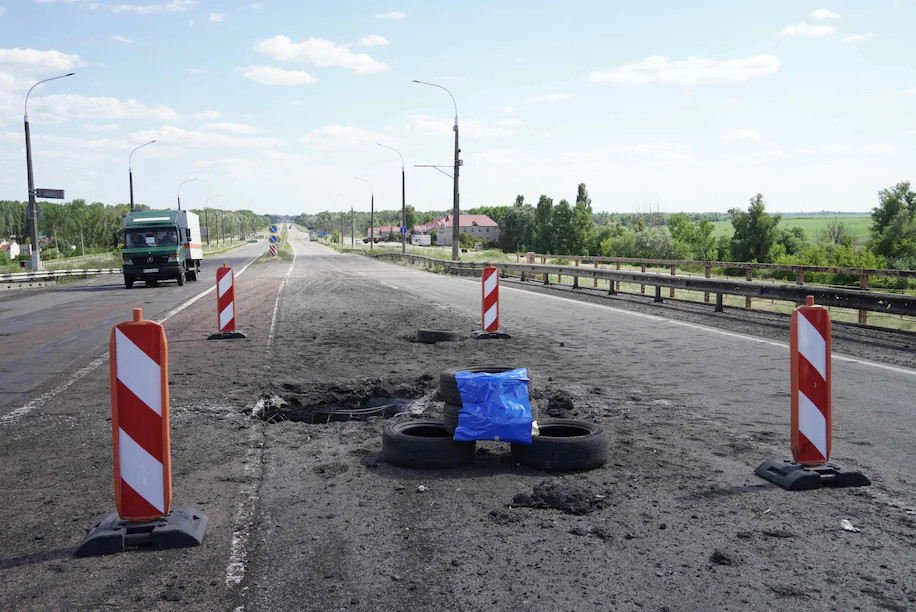
Craters on Kherson's Antonovsky Bridge over the Dnieper River were caused by a Ukrainian rocket strike. (AFP/Getty Images)
The bridge, more than a half-mile long, provides the main supply route between Russia’s 49th Army stationed on the west bank of the river and the rest of the Russian force, and the attack leaves the troops there “highly vulnerable,” the tweet added.
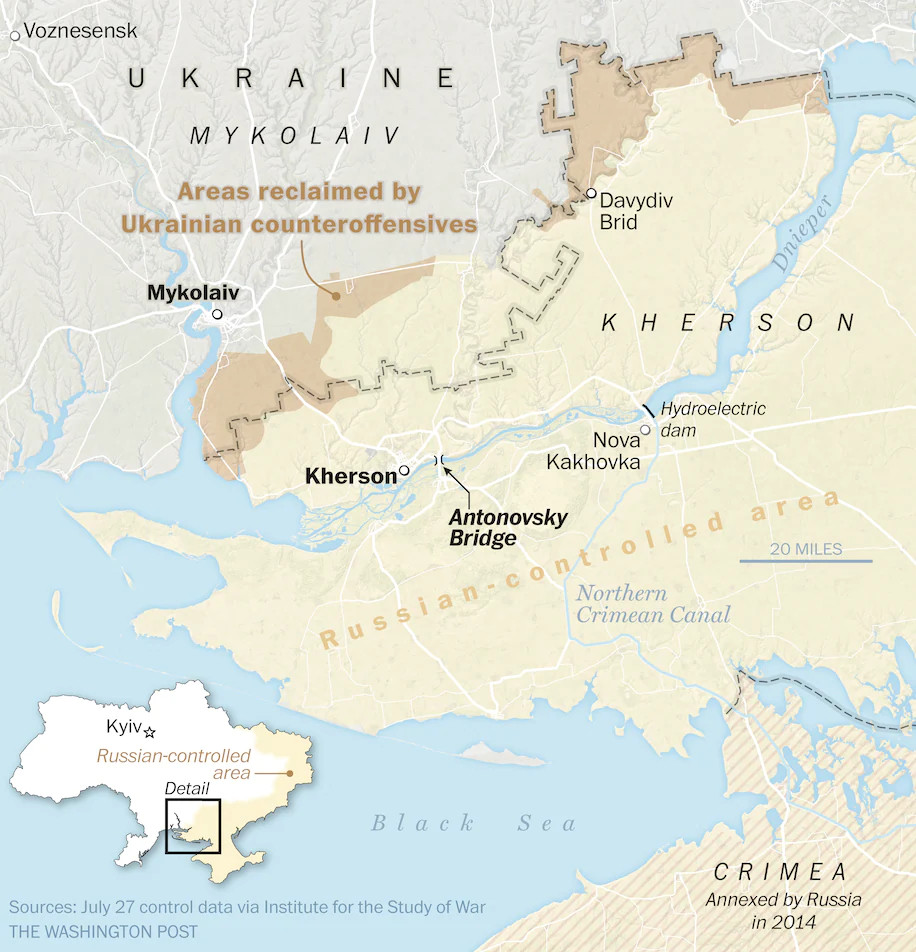
It remains unclear whether strikes have permanently rendered the bridge unusable, but videos posted on social media showed significant damage and signs indicating the bridge is at least temporarily closed.
“The Ukrainians have changed the character of the conflict with their ability to attack behind Russian lines,” O’Brien said. “What we will see in the next few months is the initiative swing back to the Ukrainians, and then we will have to see if the Ukrainians can push the Russians back.”
The biggest effect of the HIMARS so far has been to erode the Russians’ overwhelming artillery advantage, both in terms of the number of guns and the rounds they can fire, said Rob Lee of the Philadelphia-based Foreign Policy Research Institute.
After Russia pivoted to the eastern front and began slowly taking territory from the Ukrainians, the artillery edge “was probably a deciding factor,” he said. “They were firing by an enormous magnitude more rounds a day than Ukraine was, and over time it becomes really hard. Soldiers can’t withstand that.”
By using the HIMARS to destroy ammunition stocks, Ukraine has forced the Russians to move ammunition depots farther away from the front, lengthening their supply lines and complicating the logistics of getting artillery shells to the units that need them. “Russia doesn’t have a good automated logistical system; it requires a lot of manual labor, and that means it’s not very efficient,” Lee said.
By striking command and control centers, Ukraine is taking out the officers and commanders who would issue the orders to mitigate the impact of the HIMARS. “We know from the way that the Russians fight that they need someone to tell them what to do. And when you are able to kill the people that tell them what to do, you’re able to stop those folks from moving forward,” the U.S. official explained.
But while the HIMARS have blunted Russia’s ability to advance, they won’t help Ukraine make territorial gains, said Lee, a former infantry officer in the U.S. Marine Corps. That will depend more on Ukraine’s ability to field sufficient manpower, conventional artillery and ammunition to roll back Russian troops, and Russia still maintains an overall numerical edge, he said.
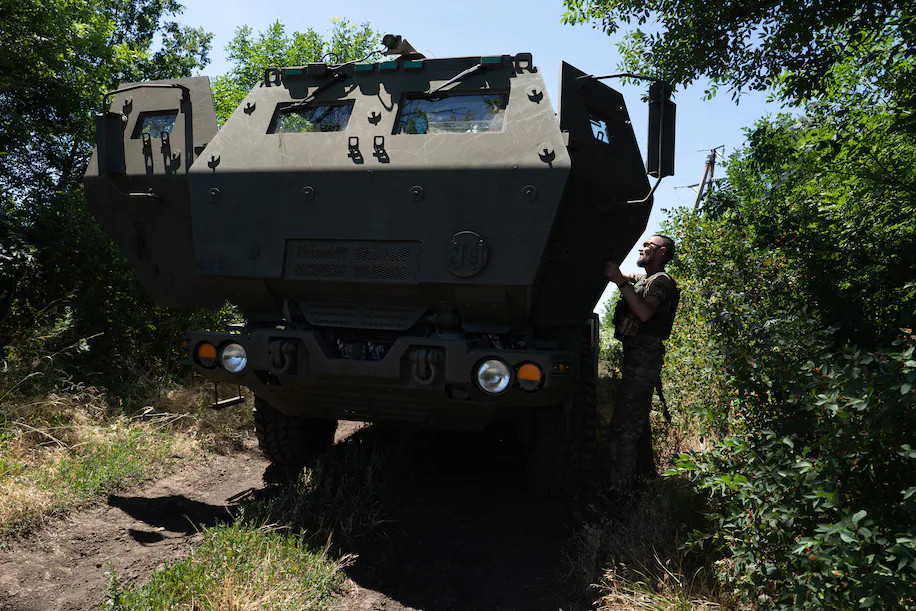
A Ukrainian soldier opens the door to a HIMARS vehicle in eastern Ukraine on July 1. (Anastasia Vlasova for The Washington Post)
There are particular concerns about whether the West will be able to continue to supply the Ukrainians with the amount of ammunition they need for their artillery, including for the HIMARS, Lee added.
That concern was echoed last week by the chairman of the Joint Chiefs of Staff, Gen. Mark A. Milley, in a briefing with reporters. Although the Ukrainians have sought a larger number of systems, “the issue will become ammunition and the consumption rates,” he said. “We think we’re okay right now.”
But looking beyond the next three months will require careful study by the Pentagon to ensure that U.S. military readiness isn’t compromised, as well as an effort to ramp up U.S. ammunition production, Milley said.
“One reason the Russians are not advancing is the HIMARS, but that doesn’t mean Ukraine is able to retake territory, either. We could see a stalemate-ish situation with not much advancing on either side,” Lee said.
“It comes down to sustainability, and it’s not clear which side has the better angle there.”
By Liz Sly ... Liz Sly is a correspondent-at-large covering global affairs. She has spent more than 17 years covering the Middle East, including the first and second Iraq wars. Other postings include Washington, Africa, China, Afghanistan and Italy.
-------------------------------------------
War in Ukraine: What you need to know
- The latest: The United Nations has expressed hope that the first grain shipments from blockaded Ukrainian ports could start Friday. However, the exact coordinates needed to ensure a safe passage for ships were still being negotiated on Thursday, U.N. aid chief Martin Griffiths said.
- The fight: Russia’s recent operational pause, which analysts identified in recent weeks as an effort to regroup troops before doubling down on Ukraine’s south and east, appears to be ending. Russia appears set to resume ground offensives, with Defense Minister Sergei Shoigu telling troops on Saturday to intensify attacks “in all operational sectors” of Ukraine.
- The weapons: Ukraine is making use of weapons such as Javelin antitank missiles and Switchblade “kamikaze” drones, provided by the United States and other allies. Russia has used an array of weapons against Ukraine, some of which have drawn the attention and concern of analysts.
- Photos: Post photographers have been on the ground from the very beginning of the war — here’s some of their most powerful work.
- How you can help: Here are ways those in the U.S. can help support the Ukrainian people as well as what people around the world have been donating.
- Read our full coverage of the Russia-Ukraine crisis. Are you on Telegram? Subscribe to our channel for updates and exclusive video.